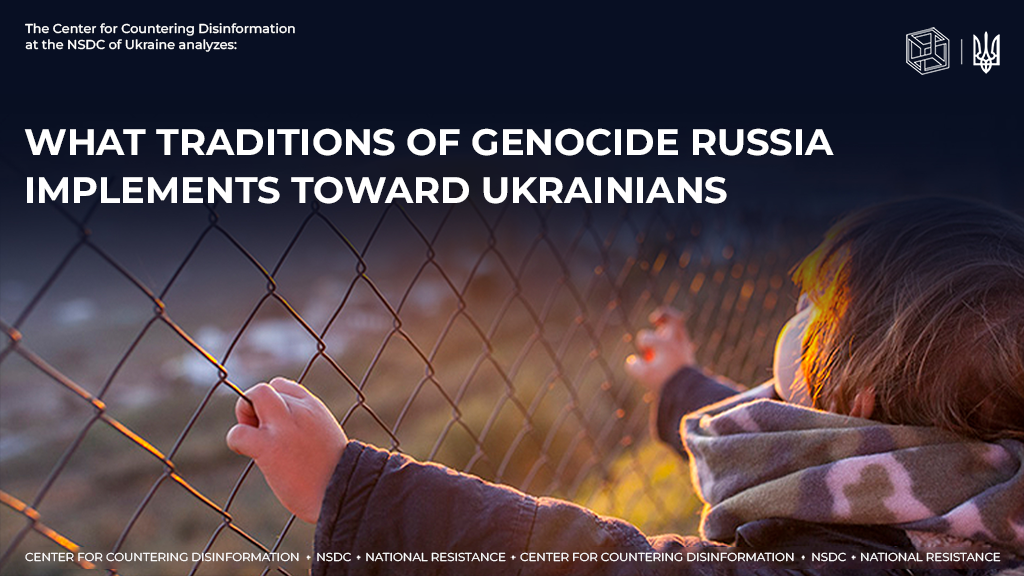The Center for Countering Disinformation at the National Security and Defense Council of Ukraine analyzes the traditions of systematic violations of international law on the forcible deportation of Ukrainians from the temporarily occupied territories.
The history of Ukraine-russia relations fixes numerous cases of Ukrainian citizens’ deportation. This is the example of russia’s war crime, the genocide of the Ukrainian nation and the modern manifestation of colonialism.
Ukrainians in the east and south of Ukraine are taken to temporarily occupied territories of Ukraine or the Crimea and then to the russian federation. The displacement requires passing through filtration camps. The people escaping war are detained, interrogated, and undergo body searches. Their personal data are collected, and various certificates are handed over.
For instance, residents of Mariupol passing filtration were transferred to the Rostov region by bus and then placed in special camps, hostels, and resorts across the territory of the russian federation. They were forced to get russian passports and apply for a job through the employment agencies. Then they were handed over the papers forbidding them to cross the border of the russian federation within a two-year term.
People with the pro-Ukrainian civic position may fail to pass filtration. Those who do not succeed in passing through the filtration process are believed to be “dangerous to the russian regime”. Therefore, they are arrested, abused, threatened, induced to collaborate, whereas the “unreliable” are tortured.
Although nowadays russia, following the steps of Nazi Germany since the times of the Second World War, is not deporting ostarbeiters to do community service, however, puts many of Ukrainian citizens on the spot. Their passports are taken away, they are banned from leaving the remote regions of russia, where they “were evacuated without Ukraine’s notice” for an unlimited time period
The russian military did not allow the local residents to move in the direction of Kyiv during the temporary occupation of part of the Kyiv region in March. On the contrary, they opened their own corridor for civilian cars and buses to the territory of Belarus, an accomplice in russia’s war against Ukraine. Some people were only informed about the direction of their dislocation on board of the vehicle for deportation.
The people from the eastern Ukraine are mostly taken to the borderline regions of the russian federation, and from there, to remote economically depressed regions. There are 4 camps in the Penza region alone, where deported Ukrainians from the temporarily occupied regions of Ukraine were moved back in February, before the full-scale invasion.
There are known cases of deportation to various regions: to Siberia, beyond the Arctic Circle, to Chechnya, Dagestan, and Ingushetia, to the Far East. The russian Orthodox Church takes part in this process as well. They settle the deported people in their churches and monasteries.
There were cases when Ukrainians were engaged in spreading russian propaganda. At the russian railway stations they were met by local law enforcement officers, journalists and volunteers who were supposedly helping the “refugees” while filming that on cameras for TV.
The occupiers are also “tackling” the issue of Ukrainian orphans from the temporarily occupied regions of Ukraine who can obtain russian citizenship through a simplified procedure. Ukrainians whose children were born in deportation cannot take them out of russia because of a russian birth certificate.
russian filtration camps in the temporarily occupied territories of Ukraine, the existence of which is vehemently denied by the representative of the russian federation to the UN, v. nebenzya, are a continuation of “historically proven” russian methods of searching for “unreliable”.
In the last century, indigenous peoples of Ukraine experienced several deportations caused by russia. Forced evictions of individuals and peoples from the very beginning were an integral element of the empire’s repressive and punitive system.
The first mass deportations of Ukrainians under the Soviet regime took place during the so-called dispossession in 1929-1930s. At that time, 150 000 people were evicted to the northern regions of the USSR and Siberia.
Considering the western Ukrainian lands as a future rear in the planned expansion into the countries of Western Europe, the Soviet authorities set out to clear this territory from “unreliable socio-political elements.” One of the reasons for deportation was clearing the region from “banderites”, the families of members of the OUN (Organisation of Ukrainian Nationalists) and UPA (Ukrainian Insurgent Army).
For instance, in 1944–1952, more than 482 000 Ukrainians were relocated from Halychyna to Prychornomoria and from Slobozhanshchyna to Donechchyna.
And in 1947, the most massive deportation was carried out by the Soviet authorities in the Western regions. About 78 000 Ukrainians were deported to Kazakhstan and the remote regions of Siberia in just one day.
This forced deportation caused the destruction of the historical, material, moral and cultural values of Lemkivshchyna, Western Boikivshchyna, Nadsiannia, Kholmshchyna, and Pidliashshia, and put entire ethnic groups of Ukrainian people at risk of extinction. The goal of the Crimean Tatars deportation in 1944 was similar — destruction of the identity of the entire nation that destroys the idea of “russian Crimea since time immemorial” by its very existence.
There is evidence that Ukrainian women and young girls were specially selected and sent in separate echelons to the far reaches of russia to work in the shower and laundry facilities of military garrisons, where there were few women among the residents.
The Soviet authorities considered this method effective in the fight against the Ukrainian rear. The relations between the deportees and local residents were strained. Mass political work was carried out among the deportees, and those dissatisfied with the political system were arrested and tried as “nationalist elements”.
Russian authorities are trying to present their actions as aid to Ukrainian refugees, who are fleeing the shellings arranged by the so-called “Nazi regime”. According to Article 49 of the Geneva Convention Relative to the Protection of Civilian Persons in Time of War of 1949 and Article 85 of the Additional Protocol I to the Geneva Conventions, all this contradicts international humanitarian law and is considered a crime.
Among other principles of international law violated by Russia, there is Article 7 of the Rome Statute of the International Criminal Court. It defines deportation or forcible transfer of population as a crime against humanity. And Article 8 of the same Statute qualifies such actions as a war crime.
Given that russia also unlawfully detains Ukrainian citizens in filtration camps, it violates Article 9 of the International Covenant on Civil and Political Rights and Article 5 of the European Convention on Human Rights. Both documents declare people’s right to liberty and security and prohibit unlawful arrest or detention in contravention of the provisions.
The documents mentioned above prohibit the forced resettlement of civilians from the occupied territory to the territory of the occupying state and their arbitrary arrest or detention without due procedure. These norms must be observed by any state, regardless of whether it has ratified the Geneva Conventions.
Forced displacement of children is carried out with the intent to wipe out a national, ethnic, racial, or religious group and is considered a violation of the Convention on the Prevention and Punishment of the Crime of Genocide (Genocide Convention).
Citizens of Ukraine must be evacuated to the territory of Ukraine in accordance with the principles of international law. Evacuation to the territory of the aggressor country is possible only if Ukraine does not agree to accept its citizens to the government-controlled territories.
In the democratic world, the practice of deportations is condemned as a component of the repressive policy of the totalitarian regime. However, russia continues to use shameful methods of genocide. The scale of the forced deportation of Ukrainian citizens to the territory of the russian federation demonstrates that this crime was systematically well-planned in advance, as it was before all past deportations.
Since the beginning of 2022 the Kremlin has been sending the guidelines with information on how many camps for deportees are needed and how many people they are supposed to accommodate, to the regions where Ukrainians are now being taken.
At the beginning of 2021, the minister of defense of the russian federation s. shoigu announced a strange initiative to build new metropolitan cities in Siberia. The projects were named “Cedar Tract” and “Aluminum Valley”. In fact, the Kremlin planned to create concentration camps for Ukrainians in Siberia.
In this way, russia creates the conditions for the forced cultural assimilation of displaced Ukrainians in the russian federation to erase their Ukrainian cultural identity.
In its previous publications, the Center for Countering Disinformation at the National Security and Defense Council of Ukraine considered the disputes over russia’s forced deportation of Ukrainian citizens at the UN Security Council.
In 1944–1952, 700 000 people were forcibly deported from Western Ukraine and later recorded as “migrants” in official documents.










